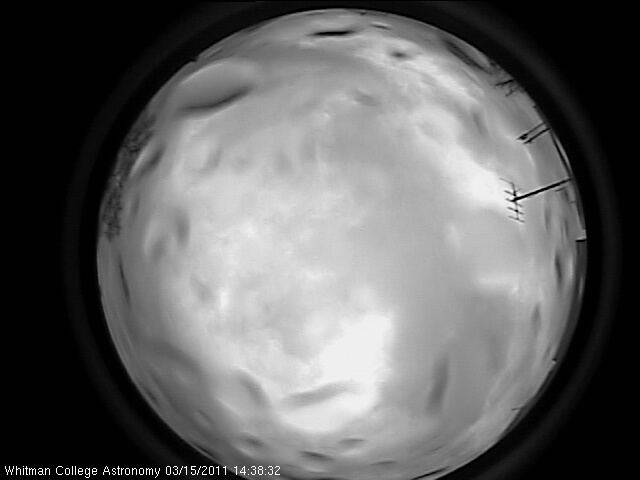New sky camera has Whitman students looking up
For eons, humans have looked to the skies for inspiration, navigation and answers to the most mysterious questions of the universe.
But our knowledge and understanding of sky and space has come a long way since the earliest depictions of the heavens were embossed on the walls of caves or sketched onto pieces of parchment. Modern technologies now allow us to observe, in great detail, the constantly changing skies above us – technologies such as Whitman’s new sky camera, which was installed this winter on the roof of the Hall of Science.
 |
|
The Whitman skycam captures an image of a rainy March afternoon in Walla Walla. The dimples seen in the image are raindrops. (Click the image to visit the real-time skycam Web page.) |
The “skycam” was hand-built and installed by Zachary Schierl '12, and Sam Schonfeld '12, along with Nathaniel Paust, assistant professor of astronomy. The equipment consists of a Mintron monochromatic security camera outfitted with a “fish eye lens” that allows the camera to see from horizon to horizon. Capturing an image every 10 seconds — 24 hours a day, seven days a week — the camera captures and records a staggering 8,640 pictures of the Walla Walla sky each day.
But what will become of the more than three million pictures taken by the camera each year?
“The simplest short term goal is to show my “Astronomy 110” students how the sky moves over the course of a night. I'm also using it in class to allow students to know whether the roof is open for the observing portion of the “Astronomy 110” lab,” Paust said. “Longer term, the camera will help us make determinations of the actual astronomical quality of Walla Walla. Environmentally, the camera also should let us make some determinations on light pollution and whether it gets better or worse over the next several years.”
The camera provides the department with a way to monitor real-time weather conditions, light pollution, transient sky events such as iridium flares (caused by the reflective surfaces of the satellites used for satellite telephones) and archive long-term weather data. The camera’s images, which are displayed in real-time on an astronomy department Web page, also benefit students and faculty in other departments, Paust said.
“Fred Moore, professor of physics, has a student looking at the efficiency of solar panels as a research project. They're going to use the sky camera images to judge levels of sunlight during the day,” he said.
For Schierl, an astronomy-geology major, and Schonfeld, an astronomy-physics major, the skycam project has served as a fascinating independent study project, offering the opportunity to work alongside their professor and take part in applied astronomical research.
“The ability to do research with professors is one of the fundamental benefits of coming to a small school like Whitman, where professors are accessible and they really get to know the students,” Schonfeld said. “Having research opportunities available for students is one of the big ways in which Whitman promotes the sciences … it’s a great opportunity which is often very difficult at larger schools.”
The skycam project team is still in the process of assessing the full capabilities of the camera, but they have determined that on a moonless night, the sensitivity of the camera approximately replicates what would be seen by the human eye. They also have been successful with preliminary satellite tracking using the camera. But the real value of the project, Paust said, will be seen when they have a year or two of data to analyze and interpret.
“I originally was going to buy a commercial sky camera, but I decided that it would be an interesting student project to actually build the camera with the various components,” Paust said. “We had to directly import some of the electronics from Taiwan — after negotiating prices via Skype — but in the end, the camera cost about half the price of a commercial solution and it gives results slightly better than what we would have been able to purchase.”
To see images of Whitman’s sky camera, click here.
—Joe Gurriere